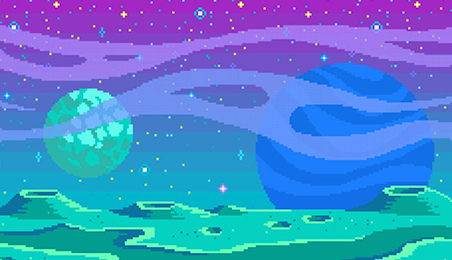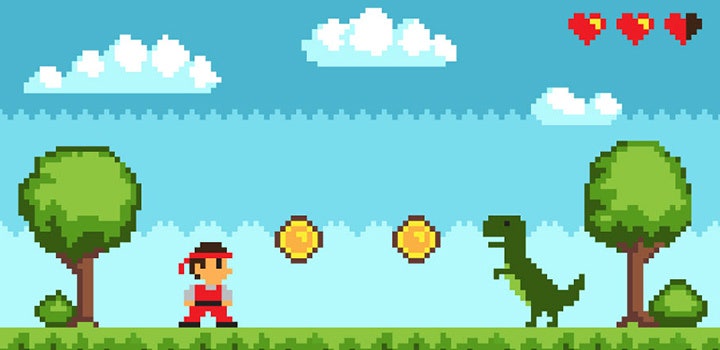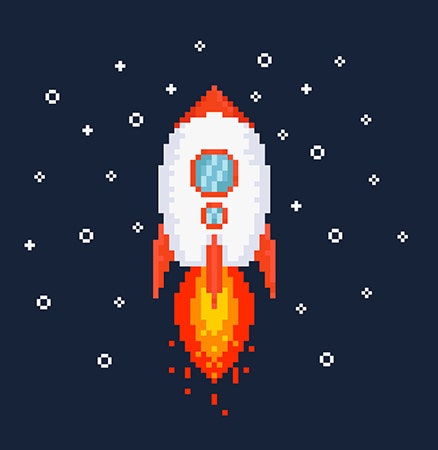Explore how to make pixel art.
Pixel art is a style that evokes the old, low poly looks of landmark games like the early Final Fantasy or Super Mario titles. Despite the near-constant upgrade in graphical fidelity, retro-inspired pixel art remains popular, with many artists and game developers intentionally replicating, experimenting, and evolving the classic low poly style.
Join pixel artists and learn how to draw from the past to create new visions and even make your own pixel art games

What is pixel art?
The visual, pixel-based art style of the Atari 2600, Nintendo Entertainment System, SEGA Genesis, and early computer graphics influenced — and continue to influence — millions of creative minds. Modern graphical resolution is better than anything earlier gaming systems offered, but the aesthetics and emotional association of pixel art still have appeal.
Pixel art isn’t just art made of pixels – it’s art that evokes the look of early computer and video game imagery. That includes everything from Pong to Sonic the Hedgehog.
Early video games were lower resolution — it was impossible to hide the tiny rectangles that created the worlds of Space Invaders and Donkey Kong — so pixel art arose out of necessity.
The artists making video games in the 1970s and 1980s had to innovate and boil images down to their essence. A few red pixels on a character sprite would have to suggest Mario’s hat and one or two pixels would have to be understood as his hands or face.
In the 16-bit era of the 1990s, pixel art became more detailed, but the spirit remained the same. Artists had a bigger canvas to work with, but they were still working with individual pixels — each of which played an important role in creating the overall image.

Different pixel art styles.
Pixel art can be categorised into two distinct pixel art styles, though these can be merged with other styles, or even each other, to evolve the form. When you reduce pixel art down to the main two styles, you have:
Isometric pixel art. If you’ve ever played Pokémon on the GameBoy or an old-school JRPG like Final Fantasy or Zelda, you might have a good sense of isometric pixel art. These are usually top-down, and often give a sense of depth with a 3-dimensional appearance, despite being 2D art.
Non-isometric pixel art. Non-isometric pixel art is usually side on and flat, focusing on the side of buildings or the top, rather than a 3-dimensional image. This style of pixel art is especially common in side-scrolling games – think sprites and environments like those seen in the early Mario games.

Images by Gerardo Quiroz


Start drawing with pixels.
To create pixel art, you need a high degree of attention to detail with minimal resources. Unlike a painter who can literally use broad strokes, a pixel artist must focus on the placement of every single unit in their image. A good pixel artist can capture the fundamental form of a subject while still simplifying it.
Get started with pixel art by studying the pixelated sprites you already admire from the work of past artists. Recreating classic pixel art can be a painstaking process, but following the pixel path of another artist can be enlightening.
Of course, you should never pass off something you’ve copied as your own — when working with pre-existing art, credit the creators appropriately.
Top tips on how to do pixel art.
Here’s some simple steps to follow to help you get started on creating your pixelated art:
Select the right software.
Depending on your goals, you can use dedicated pixel art software, or even popular image editors like Adobe Photoshop. Consider the tools you may want to use and what you intend to do with the pixel art before you begin.
Grids are great.
Software that can give you a pixel grid can help you get into the granular details when you make pixel art. Using a grid for guidance, you can fill each pixel with purpose and get a better idea of the image you’re creating.
“References from real life don’t apply as nicely in pixel art as they do in other digital art disciplines,” says pixel artist Emi Monserrate. “You have to learn ways of simplifying complex shapes such as hands or facial expressions.”
Learn traditional art.
Anatomy, composition, silhouettes – while pixel art may be a bit different from a self-portrait, understanding traditional art fundamentals will directly translate to your ability to draw pixel art.
By learning how things should look, you can better simplify and show important features in your art. Reference this with pixel art of varying styles and you’ll be set.
Consider your canvas size.
To determine your canvas side, you need to consider the size of your sprite and any backgrounds. The larger the resolution, the more details you can add.
Traditionally, pixel art uses smaller canvases. However, nothing is stopping you from creating more detailed pixel art. Consider your output first, then you can decide on your ideal resolution and resize if needed. If you’re ever unsure, there’s a lot of guidance online from pixel artists.
Tools to help you create pixel art.
Anything that lets you place squares on a grid is a potential pixel editor. Adobe Photoshop, for instance, has all of the basic functions you need to make pixel images, and Adobe Illustrator lets you align your work on a pixel grid to get the granular control you need for good-looking retro images.
Regardless of the program you use, you’ll spend a lot of time with the Pencil and Line tools. Pixel artists do use Fill and Brush tools in their craft, but deliberately and sparingly — a single pixel can make all the difference. Being able to move those precisely and easily is key when it comes to your software choice.
Make sure to avoid saving your pixel art as a JPG – it’s best to choose PNG or GIF files. It’s a common file type and often a default, but the compression that JPG applies can compromise the quality of pixel art and disrupt the pixel-by-pixel work of the artist.
With our free online tools, you can also convert your PNG files to PDF for easy printing, sharing, and collaborating.

Pixel art Photoshop tools.
Creating pixel art with Adobe Photoshop is easy, thanks to the suite of tools at your disposal.
- Photoshop lets you easily create and scale a canvas by pixels, and by zooming in, you can get a clear look at each individual pixel.
- By reducing your brush size or using the Fill tool, you can painstakingly place every pixel perfectly.
- Create grids to show for every pixel, and establish swatches for that limited-colour palette, retro pixel look.
Pixel art Illustrator tools.
Using Adobe Illustrator to create pixel art means you can easily scale your finished piece for use online with no quality loss, as compared to other programmes. With convenient pixel grids, and a customisable canvas, Illustrator can be an easy way to create effective pixel art.
Making a career as a pixel artist.
Pixel art has a thriving online community. Communities like Behance allow artists to share their work and portfolios to get their work in front of potential employers.
Drawing classics like Kirby, Pokémon, or Pac Man is always fun, but social media accounts like Pixel Dailies encourage artists to create work based on a theme – like breakfast, epic hero, zombie outbreak, or relaxation. A little inspiration can be just what you need to start making pixel art.
There’s a demand for pixel art, but it tends to be fairly niche. Most of it comes from the video game industry. Plenty of modern video games like Shovel Knight and Enter the Gungeon emulate NES-style graphics, despite being designed for modern consoles and PCs.
Video games are a group effort and participating in game jams (activities where developers, artists, writers, and designers collaborate on a tight deadline to create a game) can be a good way for an aspiring pixel artist to integrate themselves into a larger team.
“Art is needed. It’s a good way to participate in something more complex,” says Monserrate. “Having a team of people helping you on a project within a very specific time frame will help you to discover your strengths and limitations.”
The days when pixel art was requisite may be over, but it lives on as a specific artistic choice. Whether it’s making stand-alone art, animated sprites, or your own video games, you’ll always evoke nostalgia when you work with pixels. But pixel art is more than just a throwback. The sprites might be simple, but the art is as complex as ever.
Pixel art FAQs.
How do I create pixel art?
Making pixel art is a skill, but it’s easy to get started. Open the program of your choice and begin filling in those pixels one-by-one. If you’re not sure where to begin, both Adobe Illustrator and Photoshop offer everything you need to make stunning pixel art.
Is pixel art easy?
No, pixel art isn’t an artistic shortcut and requires a lot of understanding. Unlike traditional art, you’re working with minimal space and detail. That means you need to be able to convey anatomy, character, and expression with a reduced colour palette and minimal detail.
What do professionals use for pixel art?
Commonly used programs to create pixel art include Adobe Photoshop, Adobe Illustrator, and Aseprite. Depending on your goals, each may have different benefits.
What are the limitations of pixel art?
Pixel art is generally based on the 8 or 16-bit pixel-based art styles of older games, meaning a reduced palette and resolution. Games like Shovel Knight, Stardew Valley, and Octopath Traveller have added a modern quality to pixel art, pushing the boundaries on what a low-resolution art style is capable of representing.
Contributors
Do more with Adobe Illustrator.
Create logos, icons, charts, typography, handlettering and other vector art.